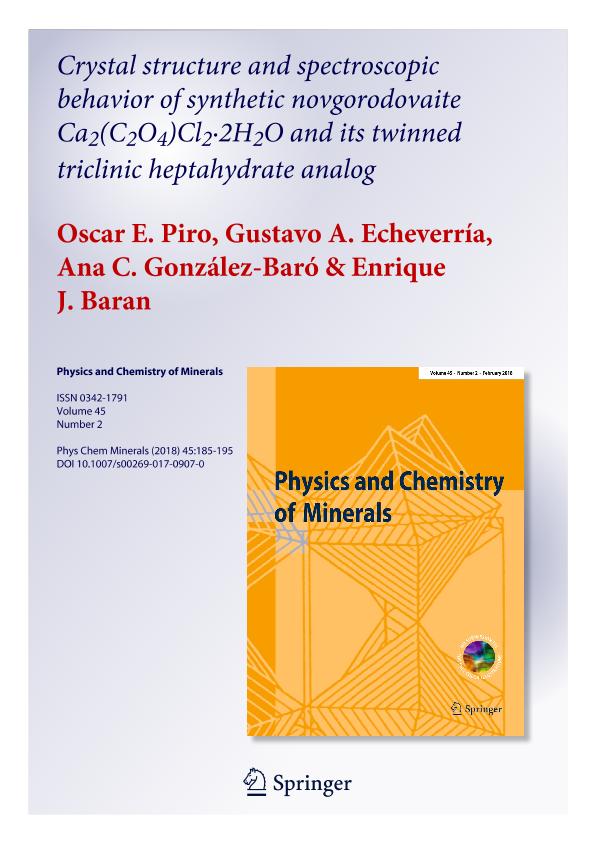Artículo
Crystal structure and spectroscopic behavior of synthetic novgorodovaite Ca2(C2O4)Cl2·2H2O and its twinned triclinic heptahydrate analog
Piro, Oscar Enrique ; Echeverría, Gustavo Alberto
; Echeverría, Gustavo Alberto ; Gonzalez Baro, Ana Cecilia
; Gonzalez Baro, Ana Cecilia ; Baran, Enrique José
; Baran, Enrique José
 ; Echeverría, Gustavo Alberto
; Echeverría, Gustavo Alberto ; Gonzalez Baro, Ana Cecilia
; Gonzalez Baro, Ana Cecilia ; Baran, Enrique José
; Baran, Enrique José
Fecha de publicación:
02/2018
Editorial:
Springer
Revista:
Physics And Chemistry Of Minerals
ISSN:
1432-2021
e-ISSN:
0342-1791
Idioma:
Inglés
Tipo de recurso:
Artículo publicado
Clasificación temática:
Resumen
Synthetic novgorodovaite analog Ca2(C2O4)Cl2·2H2O is identical to its natural counterpart. It crystallizes in the monoclinic I2/m space group with a = 6.9352(3), b = 7.3800(4), c = 7.4426(3) Å, β = 94.303(4)°, V = 379.85(3) Å3 and Z = 2. The heptahydrate analog, Ca2(C2O4)Cl2·7H2O, crystallizes as triclinic twins in the P1 ¯ space group with a = 7.3928(8), b = 8.9925(4), c = 10.484(2) Å, α = 84.070(7), β = 70.95(1), γ = 88.545(7)°, V = 655.3(1) Å3 and Z = 2. The crystal packing of both calcium oxalate?chloride double salts favors the directional bonding of oxalate, C2O4 2−, ligands to calcium ions as do other related calcium oxalate minerals. The π-bonding between C and O atoms of the C2O4 2− oxalate group leaves sp2-hydridised orbitals of the oxygen atoms available for bonding to Ca. Thus, the Ca?O bonds in both calcium oxalate?chloride double salts are directed so as to lie in the plane of the oxalate group. This behavior is reinforced by the short OO distances between the oxygens attached to a given carbon atom, which favors them bonding to a shared Ca atom in bidentate fashion. Strong bonding in the plane of the oxalate anion and wide spacing perpendicular to that plane due to repulsion between oxalate π-electron clouds gives rise to a polymerized structural units which are common to both hydrates, explaining the nearly equal cell constants ~7.4 Å which are defined by the periodicity of Ca-oxalate chains in the framework (monoclinic b ≈ triclinic a). When compared with novgorodovaite, the higher water content of Ca2(C2O4)Cl2·7H2O leads to some major differences in their structures and ensuing physical properties. While novgorodovaite has a three-dimensional framework structure, in the higher hydrate, the highly polar water molecules displace chloride ions from the calcium coordination sphere and surround them through OwHCl hydrogen bonds. As a result, polymerization in Ca2(C2O4)Cl2·7H2O solid is limited to the formation of two-dimensional Ca2(C2O4)(H2O)5 slabs parallel to (001), inter-layered with hydrated chloride anions. This layered structure accounts for (001) being both a perfect cleavage and a twin interface plane. The infrared and Raman spectra of both salts are also briefly discussed.
Archivos asociados
Licencia
Identificadores
Colecciones
Articulos(CEQUINOR)
Articulos de CENTRO DE QUIMICA INORGANICA "DR. PEDRO J. AYMONINO"
Articulos de CENTRO DE QUIMICA INORGANICA "DR. PEDRO J. AYMONINO"
Articulos(IFLP)
Articulos de INST.DE FISICA LA PLATA
Articulos de INST.DE FISICA LA PLATA
Citación
Piro, Oscar Enrique; Echeverría, Gustavo Alberto; Gonzalez Baro, Ana Cecilia; Baran, Enrique José; Crystal structure and spectroscopic behavior of synthetic novgorodovaite Ca2(C2O4)Cl2·2H2O and its twinned triclinic heptahydrate analog; Springer; Physics And Chemistry Of Minerals; 45; 2; 2-2018; 185-195
Compartir
Altmétricas



